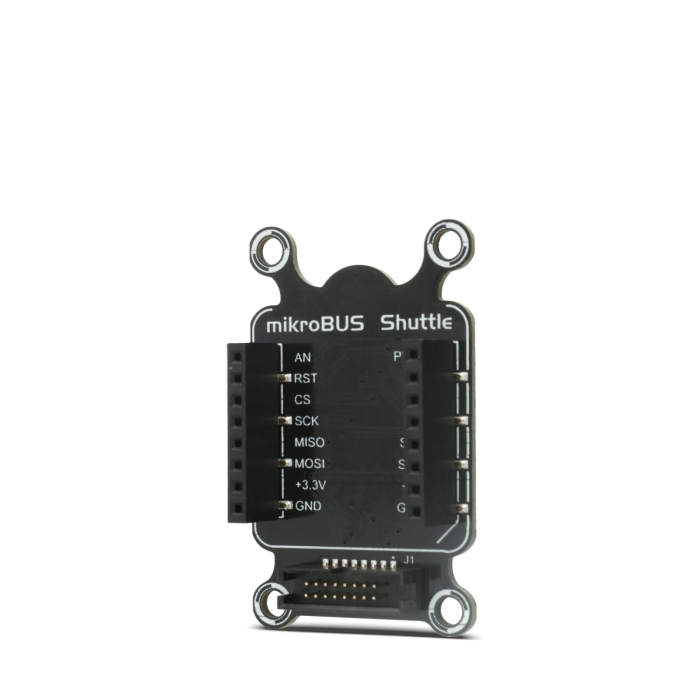MIKROE mikroBUS Shuttle
mikroBUS Shuttle is a small add-on board, which is intended to be used with Shuttle Click, in order to expand the mikroBUS™.
Product Overview
Combine click boards™ with ease
mikroBUS Shuttle is a small add-on board, which is intended to be used with Shuttle Click, in order to expand the mikroBUS™ with additional stacking options. This small add-on board has one mikroBUS™ equipped on itself and it is connected to the Shuttle Click via the flat ribbon cable (20cm). One Shuttle Click can support up to four mikroBUS Shuttles, allowing simple and elegant stacking solution for Click board™ line of products.
Note: The mikroBUS Shuttle already comes with a flat ribbon cable (20cm) in the package, that you can use to connect with the Shuttle Click.
mikroBUS Shuttle is an ideal solution when there is a demand to have more Click boards™ than the development system is able to support. Being connected with the flat ribbon cable to Shuttle Click, mikroBUS Shuttle allows being freely positioned according to the requirements of the application. Four mounting holes on the corners of the mikroBUS Shuttle add-on board allow it to be fixed in the desired position.
mikroBUS Shuttle is designed as an add-on board for the Shuttle Click, which carries one mikroBUS™ slot. Besides the mikroBUS™ slot, it is equipped with one ICD BOX header, used to connect mikroBUS Shuttle to the existing Shuttle Click. It can be connected to one of the four available ICD BOX headers of the Shuttle Click, with a flat ribbon cable.
mikroBUS™ socket on mikroBUS Shuttle can be populated with any Click board™ from our Click board™ range of products. If there is a need to fix mikroBUS Shuttle in a place, there are four mounting holes with the inner diameter of 3.2mm, that can be used for this purpose. This way, the Click boards™ can be stacked in a very simple and practical way. Having this kind of stacking topology, allows for easy manipulation and reconfiguration of the stacked Click boards™, retaining a perfect connection quality at all times.
When there's a need to expand the development system with even more mikroBUS™ slots, one of the free mikroBUS shuttles can be populated with yet another Shuttle Click, allowing even more connections. This makes the stacking capacity almost unlimited. However, attention should be paid not to make mikroBUS™ lines too long. In situations like this, the frequency of the communication might need to be stepped down a bit, in order to compensate for the longer mikroBUS™ signal lines.
Since all of the four headers available on the Shuttle Click share the same mikroBUS™ lines, an extra care should be taken when working with Click boards™ that share the same pins on the mikroBUS™, either for the communication (SPI, UART, I2C) or for some other purpose (RST, INT, or other pins used as GPIO). For example, I2C and 1-Wire protocols are designed with stacking in mind, so the collision avoidance mechanisms are already in place for these protocols. It is enough to change the peripheral address of the Click board™ and data collision won't be a problem anymore, even while sharing the same pins for the communication.
Also, since all the stacked Click boards™ share the same power rails, a care should be taken when combining Click boards™ with significant power consumption. The power consumption from all the Click boards™ combined should not exceed the maximum power that a development system can deliver.
Features & Specs
- Interface: Analog, GPIO, I2C, PWM, SPI, UART
- Compatibility: mikroBUS™, Shuttle
- Input Voltage: 3.3V, 5V
Documentation
Customer Reviews

Stock and Customer Discounts
Available Discounts
- $7.55 | 25+ units
- $7.16 | 100+ units





